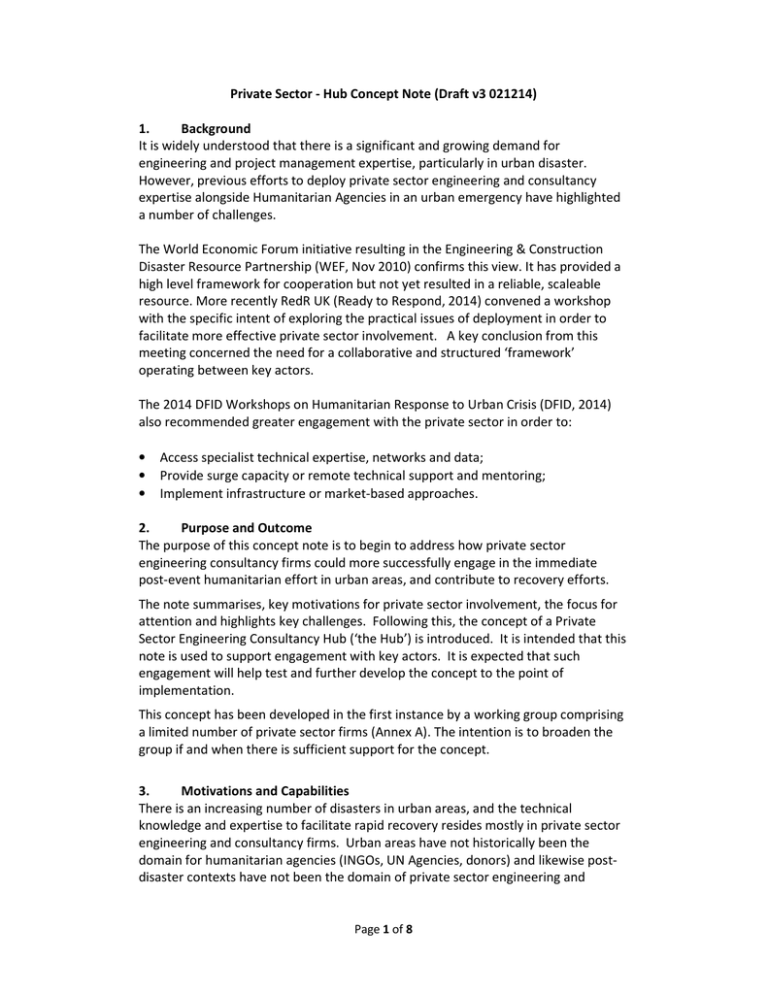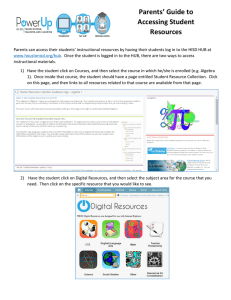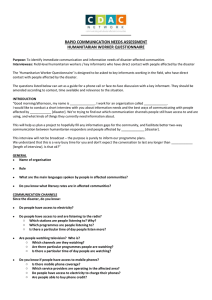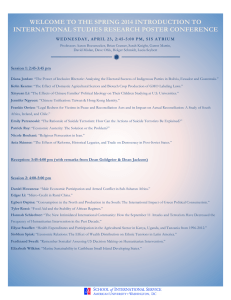Private Sector - Hub Concept Note (Draft v3 021214) 1. Background
advertisement

Private Sector - Hub Concept Note (Draft v3 021214) 1. Background It is widely understood that there is a significant and growing demand for engineering and project management expertise, particularly in urban disaster. However, previous efforts to deploy private sector engineering and consultancy expertise alongside Humanitarian Agencies in an urban emergency have highlighted a number of challenges. The World Economic Forum initiative resulting in the Engineering & Construction Disaster Resource Partnership (WEF, Nov 2010) confirms this view. It has provided a high level framework for cooperation but not yet resulted in a reliable, scaleable resource. More recently RedR UK (Ready to Respond, 2014) convened a workshop with the specific intent of exploring the practical issues of deployment in order to facilitate more effective private sector involvement. A key conclusion from this meeting concerned the need for a collaborative and structured ‘framework’ operating between key actors. The 2014 DFID Workshops on Humanitarian Response to Urban Crisis (DFID, 2014) also recommended greater engagement with the private sector in order to: • • • Access specialist technical expertise, networks and data; Provide surge capacity or remote technical support and mentoring; Implement infrastructure or market-based approaches. 2. Purpose and Outcome The purpose of this concept note is to begin to address how private sector engineering consultancy firms could more successfully engage in the immediate post-event humanitarian effort in urban areas, and contribute to recovery efforts. The note summarises, key motivations for private sector involvement, the focus for attention and highlights key challenges. Following this, the concept of a Private Sector Engineering Consultancy Hub (‘the Hub’) is introduced. It is intended that this note is used to support engagement with key actors. It is expected that such engagement will help test and further develop the concept to the point of implementation. This concept has been developed in the first instance by a working group comprising a limited number of private sector firms (Annex A). The intention is to broaden the group if and when there is sufficient support for the concept. 3. Motivations and Capabilities There is an increasing number of disasters in urban areas, and the technical knowledge and expertise to facilitate rapid recovery resides mostly in private sector engineering and consultancy firms. Urban areas have not historically been the domain for humanitarian agencies (INGOs, UN Agencies, donors) and likewise postdisaster contexts have not been the domain of private sector engineering and Page 1 of 8 consultancy firms. There is a need to marry the respective capabilities of each party for the benefit of the humanitarian effort. Private sector firms can clearly offer a range of skill sets within the urban environment, including, strategic advice, project and programme management and technical expertise (design and construction). In addition, many private sector engineering and consultancy firms will have local knowledge of how cities operate, and have an ability to mobilise local skills. There is willingness from private sector firms to supply services and meaningfully contribute to humanitarian action in urban areas, and not simply for reasons of corporate social responsibility (CSR). Indeed, if CSR were the prime driver, then collaboration is unlikely to move beyond piece-meal interventions. Meeting the humanitarian agency demand will require moving beyond the ad-hoc release of staff (on voluntary/pro bono secondments), to the fuller engagement and deployment of private sector engineering consultancy services, project /programme management expertise and urban planning services. Matching supply and demand will need to be facilitated through a common framework and formalised commercial arrangement (see section 5 & 6). Working in collaboration provides a significant opportunity for maximising private sector involvement. Under this structure, the scale of response can be better matched to the scale of event, accepting that some challenges need to be overcome. There is also a preference and benefit in doing this collectively, rather than individually, to meet the growing demand. There are a range of actors and collective initiatives by humanitarian agencies seeking greater engagement with and access to the expertise in engineering consultancy firms (Annex B). 4. Focus for Attention Given the different phases of humanitarian response it is important to recognise where there is both a demand for the skills and expertise from the private sector and challenges in mobilizing these services. Figure 1 highlights four phases, including, Preparedness, Emergency Response (or Relief), Recovery, and the Reconstruction. The conclusion from discussions within the current private sector working group is that the most challenging area lies within the immediate post event disaster relief and recovery phase, notably in an urban setting. This phase is currently typified by the need for the rapid mobilisation of resources and expertise into a troubled zone. The emergency response phase is where humanitarian agencies have a comparative advantage as they are geared up to mobilise and deploy resources quickly to meet life-saving needs (food, water, shelter, sanitation). In urban areas, technical expertise is needed to assist with contextual assessments (damage, needs, local capacity etc.) in order to enable the immediate response phase and determine strategies that promote rapid recovery. Page 2 of 8 Engaging in Immediate Response and Recovery efforts poses significant challenges for the private sector (see below). To date, private sector involvement has typically been piecemeal with reliance on individuals, either through personal volunteer commitment or limited staff secondment. This provision does not provide the problem led response that is needed, nor ensure that appropriately qualified and experienced staff are deployed. In contrast, the Preparedness, on-going Recovery and Reconstruction phases are afforded time for structured procurement and mobilisation of private sector expertise. Preparedness and DRR Reconstruction and Development Rapid Recovery Immediate Response Figure 1 Phases of Humanitarian Response to an Urban Emergency 5. Specific Challenges for Private Sector Involvement Understanding the specific challenges for private sector involvement in the Relief and Recovery Phase provides the starting point for developing future options. These are briefly listed below: Funding and Coordination • Funding may be from multiple donors with inability to leverage adequate scale of response; • Humanitarian Agencies are typically uncoordinated without a common platform for engaging with private sector consultancy firms; • The demands for technical expertise are typically undefined, with a reliance on requesting people rather than a problem led solution; • CSR budgets are inadequate for the scale of engagement needed. Commerciality • Private sector consultancy firms that attract the most expert and relevant staff can only do so because they operate on a profit making basis; • A reasonable return on investment is needed to ensure the work becomes an attractive and sustainable part of a firms overall project portfolio; Page 3 of 8 • • • Commercial organisations need to be formally contracted to provide a service with an agreed scope of work, clearly assigned liabilities with appropriate insurance and with health, safety and security fully managed; Deployment of staff can’t be allowed to unduly disrupt current operations, otherwise firms may be open to contractual claims from existing clients; Private sector firms can only absorb very limited non-recoverable costs. Procurement • Humanitarian agencies have limited experience of partnering with private sector companies; • Lack of clarity over who the contracting entity will be, leading to delays; • Responding to an event requires the ability to contract quickly; • The liabilities associated with engineering services need to be understood and contractually defined. Resource Management and Deployment • Private sector operate lean resourcing with staff all deployed on commercial projects and therefore have limited if any ‘bench’ resource availability; • Current ‘roster’ led and ‘volunteer’ approaches focus on individuals rather than capabilities and services and does not enable deep enough resource deployment to make a real difference; • Potential resources would need to be actively managed pre-event; • Individual firms with available staff may not be most suitable for current solution. Safety and Duty of Care • All commercial companies have a primary duty of care for staff in their employment which must be maintained for any secondments; • Staff must be suitably trained and prepared for any secondment. 6. The Concept – Private Sector Hub In overview, the proposed concept that could best solve the challenges and meet the need is the formation of a ‘Hub’ of private sector firms that could act as a single entity and point of contact for the purpose of responding to a humanitarian relief event, and addressing the needs of humanitarian agencies, and potentially government. By acting in unison, the Hub would have the best opportunity of leveraging skills and resources to meet specific technical challenges, particularly in urban areas. Importantly, the Hub would be in existence and prepared before an event occurred and would therefore be best placed to provide immediate and meaningful response. A schematic is shown in Figure 2. To make this work a number of arrangements would need to be in place: 1. 2. 3. Create clarity a single contracting entity / ‘client’; Identify potential Hub partners, and the range of services they might require; Development of a Hub ‘entity’ (bespoke or existing); Page 4 of 8 8. 9. 10. 11. 12. Demand Supply DfID Firm 1 Red R Firm 2 UNOPS START Firm 3 DEC Firm 4 Others Consultancy Hub Figure 2 Collective Initiatives / Operational Agencies Schematic of Private Sector Engineering Consultancy Hub Page 5 of 8 Emergency Event 5. 6. 7. Develop a collaborative arrangement with collective initiatives / humanitarian agencies, building on the coordination that already exists; Agreement on a lead Hub partner organisation and permanent secretariat; An Alliance Agreement between parties (including governance arrangements) A commercial Framework contract between the ‘client’ and the Hub partners with pre-agreed contractual terms and conditions. This would allow individual ‘call-off’ contracts in response to specific requirements Procurement of the Hub Framework services on commercially acceptable terms in order to ensure attractive competition for internal resources Advance funding after framework procurement to set-up necessary internal structures, governance board and management capabilities Development of a single Hub operating model covering resource management, training, Health & Safety, legal and insurance matters, HR and staff deployment, project management and accounting Authority to a Hub Secretariat for areas of on-going activity including, funding, partnerships/clients, legal/contracts, knowledge management and communications Lead operations manager within each Hub consultancy firm with full accountability and authorization Humanitarian Agencies 4. 7. Next Steps / Action Plan The following actions will help determine whether the concept is workable: 1. 2. 3. 4. 5. Meetings with prospective clients and collective initiatives (Annex B) to test the concept and explore potential for seed funding Hub Working Group partners to seek endorsement from own organisations and develop a Memorandum of Understanding (MoU) to frame collaboration in advance of Hub contract Understand the specific areas of technical demand from INGOs and collective initiatives Develop consultancy firm service offering Develop Hub concept further including operations and commercial model References Hyogo Framework for Action 2005-2015: Building the Resilience of Nations and Communities to Disasters. January, 2005, Geneva: UNISDR. World Economic Forum, 2010. Engineering & Construction Disaster Resource Partnership - A New Private-Public Partnership Model for Disaster Response, Nov 2010. DFID Workshops on Humanitarian Response to Urban Crisis, Workshop Report, July 2014. Ready to Respond 2014. Addressing Technical Gaps in Urban Disasters. Minutes from meeting held on 14th May, 2014. Page 6 of 8 Annex A – Private Sector Working Group Following the Ready to Respond workshop in May 2014, a Private Sector Working Group was set up comprising patrons of RedR, below, to develop the Hub concept. An independent firm of designers, planners, engineers, consultants and technical specialists offering a broad range of professional services. Employing over 10,000 staff, working within nearly 40 countries and across a full range of market sectors. An independent full service provider of consulting, design, design-build, construction, operations, and program management services. Employing over 26,000 staff on six continents and in over 70 countries. Partnering with clients in energy, water, environment, nuclear and transport infrastructure. Design led civil and structural engineers in the built environment. Employing over 100 members of staff operating from three offices based in Wimbledon, Central London and Nottingham. Focusing on residential developments, commercial, healthcare, hotels, education, leisure, cultural buildings, regeneration and retail schemes throughout the UK and overseas. A multi-disciplinary engineering, design and consultancy company working across buildings, transport, energy, environment, oil & gas and management consultancy markets. Employing over 11,000 staff within 200 offices and across 22 countries. Page 7 of 8 Annex B – Collective Initiatives and Platforms The following are currently known collective initiatives whose programmes potentially provide an interface and ‘client’ between the private sector Hub supplier and humanitarian agencies. DFID Conflict, Humanitarian and Security Department (CHASE) Goal is to prevent conflict and reduce poverty in fragile states, deliver world class humanitarian assistance, help poor countries be more resilient to disasters and support justice and freedom from violence, particularly for women and girls. Developing an ‘Infrastructure Platform’ to deploy staff to both carry out assessments and implement critical infrastructure repair projects immediately following a crisis. The Disaster Emergency Committee (DEC) The DEC brings 13 leading UK aid charities together in times of crisis: Action Aid, Age International, British Red Cross, CAFOD, Care International, Christian Aid, Concern Worldwide, Islamic Relief, Oxfam, Plan UK, Save the Children, Tearfund and World Vision; all collectively raising money to reach those in need quickly. Ready to Respond: Addressing Technical Gaps in Urban Disasters (RedR) Ready to Respond - a three year programme funded by Lloyd’s Charities Trust and delivered by international disaster relief charity RedR - is designed to ensure that people and communities affected by disasters can be quickly supported by trained professional experts from the private and humanitarian sectors. START Network Lead by ActionAid with Consortium Members including, ACF, Christian Aid, CAFOD, Care, International Medical Corps, Islamic Relief, Muslim Aid, Plan, Save the Children and Tearfund and Technical Partners including, Communicating with Disaster Affected Communities Network (CDAC-N) People in Aid. A 3 year programme to transform ‘surge capacity’. Includes three key elements, platform formation, pilot projects and training, learning and sharing of good practice and resources – includes working with the private sector. Disaster Risk Reduction and Recovery (UNOPS) Programme to build capacity for post disaster infrastructure assessments (identifying need, understanding how to assess and building capacity to deliver) WASH Cluster The Global Water Sanitation and Hygiene Cluster, or Global WASH Cluster (GWC) is a partnership grouping 32 partners and aiming at improving the coordination and the humanitarian response in the WASH Sector. SHELTER Cluster An Inter-Agency Standing Committee (IASC) coordination mechanism that supports people affected by natural disasters and conflicts with the means to live in safe, dignified and appropriate shelter. The Shelter Cluster’s scope includes all activities related to achieving the right to adequate housing with a humanitarian focus. Page 8 of 8





